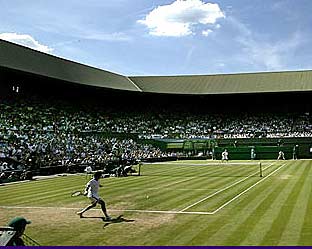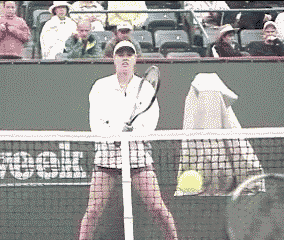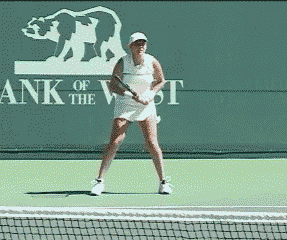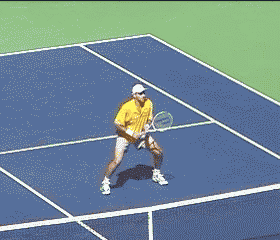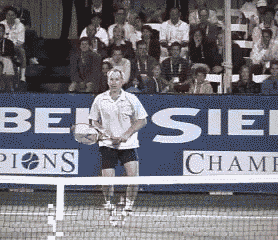|
TennisOne Lessons Tips to a Better Volley Plus How to Practice At the Net! Dave Kensler - Peter Burwash International (PBI) As I write this, Wimbledon 2006 has just concluded. Having watched this tournament on television for around 40 years, it struck me how green the grass remained from the service line leading to the net - far different from the way it used to look in a bygone era. Why are fewer and fewer pros coming to the net? Why are there only a handful of true server and volley players left on the tour? To answer these questions I go back to when I first learned to play tennis in the mid-1960’s. Three important facts about the pro tour then were:
The fact is, so few tour players venture to the net these days, it is hard to believe the volley is still a part of playing tennis! The onslaught of the two-handed backhand groundstroke ushered in the beginning of a slow decline in all court players. After all, how many of today's tour players with two-handed backhand groundstrokes have great net games? Not many. Now, the majority of players stay on the baseline (As witnessed by the wear and tear on the grass at Wimbledon ) using extreme grips to create heavy spin shots. Since they don’t venture to the net very often, they don’t have to worry about the limitations extreme grips create when coming to the net to volley. Another reason pros are afraid to come to the net is because they fear being passed. Many of them are far more comfortable hitting heavy topspin shots which bounce high and make it easier for an opponent to hit a passing shot. The concept of “chip and charge” or soft, low backspin/underspin approach shots is virtually non-existent. A shot with backspin stays low and forces the opponent to hit up, making it easier to volley. This goes in part to the issue of the one-handed vs two-handed backhand groundstroke. How many two-handed backhand players have and significantly use backspin? For that matter, how many tour players have a good underspin forehand (See previous article)? Not many. Yet referring back again to the 1960’s, hitting with underspin was used by almost all top players. Why Rush the Net? The reason for coming to the net is to end the point! It is that simple. Before even discussing grips, technique, positioning, and strategy, it is imperative to understand the purpose. Why? A baseline player may have the strategy of winning a point by attrition. They may hit 20 balls in a row to win a point. If you come to the net, the last thing you want is to have to hit 20 volleys to win a point! Catch the Volley I think there are more words used to describe how to hit a volley then any other stroke in tennis i.e. “Punch”…”Block”…”Don’t swing”…”Keep your hands in front of you”…”Don’t lose sight of your racquet” and many more. But despite that, I believe the word “catch” will help you tremendously.
Whenever I toss a ball to one of my students and ask them to catch it (forehand) or let it hit the back of their hand (backhand) they all do the same thing…Hold out their hand and let the ball come to them. Nobody ever “punches” or swings their arm to catch a ball! When you are positioned about 10 feet from the net or less, you don’t have to swing for the ball to go over the net! It is a two ounce ball and even if it is coming to you at one mph, it can hit the strings on a perfectly still racquet and still clear the net! The volley is about a 6 to 10 inch stroke depending on the length of your arm and related matters. On a forehand volley, your arm path will basically be “bent to bent." Your arm starts bent and finishes bent. Again like a catching motion. On the backhand, the arm path may go a little more from bent to straight (Not locked elbow straight!) particularly as you become more confident with the shot. Other than some strength issues, I find most tennis players have less challenges with the backhand volley in part because the hitting arm/shoulder is natusampras_2ser in front of the body whereas any body rotation on the forehand puts the hitting shoulder behind the body. Don't Punch the Volley The purpose of this article is not to refute all other phrases used to learn the volley besides “catch”…But I feel I would be remiss if I did not discuss the word “punch.” The punching motion is bent to straight. Most importantly, if you do it enough times with force, it is a great way to hurt your arm! Using a bent to straight arm motion (punch) forces your elbow to lock at contact and absorb the shock of the collision. Beside the risk of injury, punching the volley is impractical. How would you hit any of the following:
I realize that often the intent behind the word "punch" is not always literal but rather another way to help people keep their hands and racquet in front of them. However, I believe it paints the wrong picture. Use the Continental Grip for a Better Volley You can volley with any grip. Some are going to create challenges for hitting a good volley, others will be more physically limiting but you can come to the net and hit a volley holding the racquet in any desired manner.
However, in my opinion, a “continental” or “hammer” grip is the most effective one on a volley for three key reasons:
The Two-Handed Backhand Volley As I noted earlier, you can volley with any grip whether it be one-handed or two-handed. A two-handed backhand volley is going to be less challenging in a doubles match because there is less court you are responsible for covering. Yet for singles, the reduced ability to cover or “reach” can become a decisive factor.
My recommendation to those players who use a two-handed volley is to also practice hitting one-handed backhand volleys because there are times you will be forced to do so. Many times, at the pro level, a two-handed player may have to let go of the racquet to hit a one-handed shot from the baseline. However, the number of times a two-handed player may have to let go of the racquet to hit a one-handed shot at the net is far greater. At the net you have shortened the distance between yourself and the opponent so the reaction time is reduced. You may not have time to position yourself ideally because of this reduced reaction time and the one-handed backhand volley allows you to cover more court. Court Positioning Many tennis players lose confidence in their volley when in reality their volley mechanics are good. Instead, it’s their court positioning which is the real problem. Here are three volley positions which can all work well depending on the situation: BVP – Best Volley Position. You are litesampras_2ser right next to the net. This is the best position because even a ball off your racquet frame may go over the net and in. This position works well provided that your opponent cooperates and always hits the ball right to you! The problem being here of course is any lob over your head puts you in trouble and it’s easy to hit a passing shot by you. DVP – Defensive Volley Position. In this position you are standing on or around the service line. This might be the better position to be in if you are facing a player or a doubles team that lobs all the time. Why keep closing in to the net only to have the ball go over your head? The problem here is that low volleys are going to be right at your feet and that is going to force you to hit up. IVP – Ideal Volley Position. You are approximately half-way between the net and service line. This is the “ideal” position because you can close in to put away a volley or move back to cover a lob. Unless you have a reason to be in the BVP or DVP, with all things considered this is the most effective position. (Please note so there is no confusion about these positions, in a general overview of tennis playing, “ideal” is better than “best!”).
Practice Strategey Put the Ball Away: One reason people have so many problems with the volley in a match is they don’t practice what will be necessary. The typical volley practice involves a friend or teaching pros hitting nice, waist to shoulder high balls and the person at the net volleying them right back. No wonder so many players are not being able to put the volley away. When you don’t practice putting the volley away, what makes you think you will be able to do it under the added pressure of match play? I refer back to the beginning of this article and the purpose of coming to the net, that is to end the point! That is what you have to practice. Put the ball away! Hitting the Volley on the Move: I often see people practicing their volleys standing stationary at the net and hitting balls which are fed right to them. But that is not the way the game is played. During a match, whether singles or doubles, most volleys are hit while moving. Whenever I do a doubles clinic I always mention that at the start of a point, if everyone is in a traditional position, only the server's partner is at the net. Once the point begins, everyone else will (or should) be moving toward the net. That means the chances are very good that some volleys will be hit on the move. One doubles drill I like to do (singles players can do this also) is position everyone at the baseline and, once the ball is served, have all four people start to move forward towards the net (No lobs allowed). This gives people the feeling of hitting a volley while moving and the idea of "closing in."
A slight variation is to force everyone to continue to move forward until the point is over! This often gives everyone the opportunity to hit volleys from the DVP, IVP and BVP! It's great practice for moving forward, closing in, and ending the point! If you only practice hitting the volley from a stationary position with the ball above the net cord, you may always have trouble when the ball dips low. Split Step, Not Split Stop: I see this all the time, someone comes running towards the net, does a “split step” which becomes a “split stop,” then they try to get moving again but are often late in playing the next ball Watch the pros (Those that come to the net!), they use the split step to change direction and move, not to come to a complete stop. Don’t let your feet come to a grinding halt as you approach the net. Keep them moving! Good luck with taking your volley to the next level! Your comments are welcome. Let us know what you think about Dave Kensler's article by emailing us here at TennisOne.
Dave Kensler has 23 years of teaching experience with Peter Burwash International (PBI), the most successful international tennis management company. PBI directs tennis programs at 60+ exclusive resorts and clubs in 23 countries and has taught over 3 million students in their 30 year history. For information on PBI tennis destinations and employment opportunities please go to www.pbitennis.com. All PBI Tennis Professionals play with WILSON racquets and wear WILSON shoes. |

